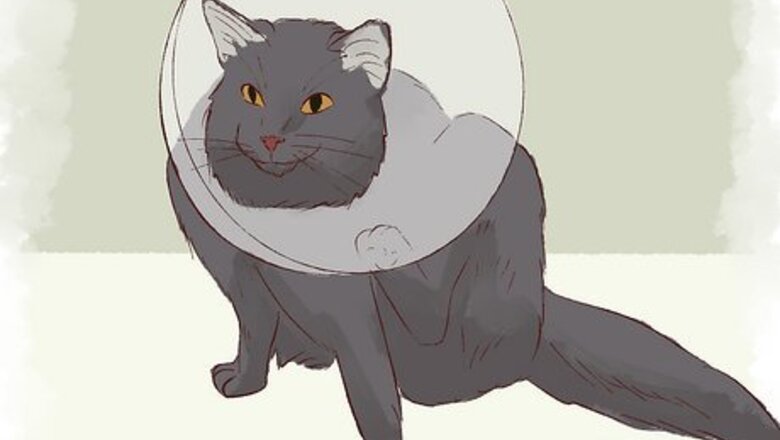
views
How to Stop a Cat from Overgrooming
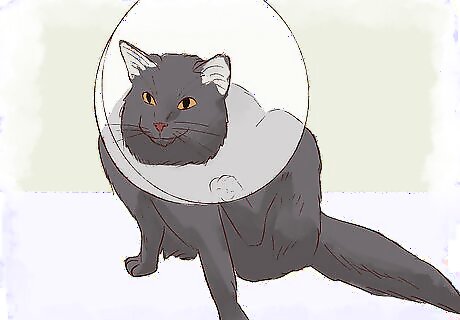
Use a head cone to stop over grooming while you determine a cause. Once you figure out why your cat is licking its fur off, you can work on treating the underlying problem. In the meantime, a head cone—also known as an Elizabethan collar or E-collar—can temporarily protect your cat’s fur and skin, and may also help break the obsessive licking cycle. Look for an Elizabethan collar at your pet supply store or online, or ask your vet’s office for one. The Elizabethan collar should be snug, but it should fit loosely enough that you can slide 2 fingers between the collar and your cat’s neck. Keeping an E-collar on a cat can be a challenge, to say the least! It may help to tie the cone to your cat’s regular collar. You can also ask your vet to show you how to fashion a harness out of gauze to help keep it on. If you need to keep the collar on for an extended time, help your cat stay clean and tidy with daily brushing. This is especially important for long-haired cats.
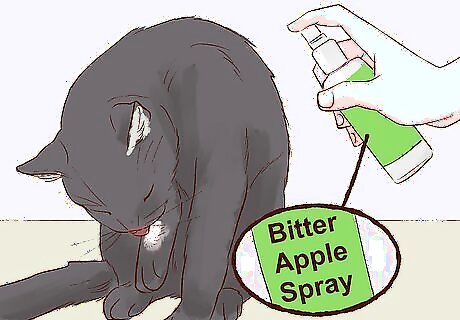
Try a bitter spray or ointment on spots where your cat is overgrooming. If your kitty tends to focus its overgrooming on a particular spot—like an itchy wound or an infected area—then a bitter spay can be a good temporary option while you treat the underlying issue. These unpleasant-tasting sprays discourage licking. Check your pet supply store or vet’s office for products such as bitter apple, cherry, or orange spray. This is also a good option if you can’t keep an E-collar on your cat. Some of these treatments also come in the form of ointments or creams. You may need to experiment with different products, since some cats actually enjoy the bitter flavors. These products can sting or irritate open wounds on your cat’s skin, so be careful to apply them around any wounds instead of directly on top of them. Check the label to make sure you know how to use the product correctly.
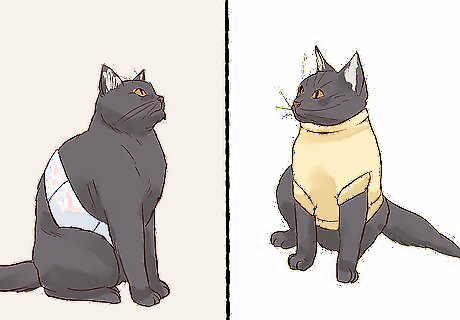
Cover problem areas with a bandage or shirt. If bitter sprays or Elizabethan collars don’t work for your cat, covering up the problem spot is another good temporary solution. Ask your vet about putting a bandage over an itchy wound or infected area on your cat’s skin to reduce licking. You can also put a baby onesie or a dog sweater on your cat to minimize grooming on the back, sides, and belly. You can even make a cute onesie for your cat out of a sock.
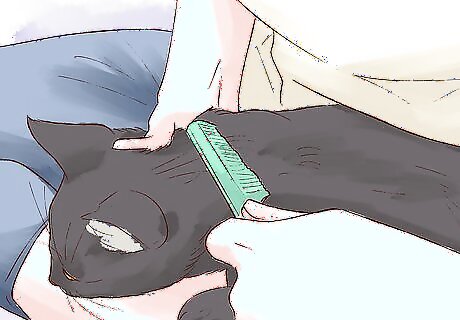
Treat your cat for fleas if you find them. If you’ve noticed your cat scratching a lot, chewing on itself, or acting jumpy and agitated, fleas may be the culprit behind the hair loss. To check for fleas, gently brush your cat’s fur with a fine-toothed flea comb. Look for fleas (small brown or black insects about the size of a sesame seed) and flea dirt, which looks like little black specks that turn red when you get them wet. If you discover fleas, you’ll need to treat your cat for them, since a bacterial skin infection can occur. Talk to your vet about different options, such as flea shampoos or spot-on treatments. These treatments can also kill other skin parasites that cause itching and hair loss, like lice and mites. In addition to laundering your cat’s bedding and thoroughly vacuuming any areas where your cat likes to sleep, you may also need to treat your home with a pet-safe pest control product, such as diatomaceous earth. Cats with flea allergies are especially prone to hair loss around their tails and hind legs, where they tend to itch the most and do the most intense grooming. You might also notice bald patches and scabs around your cat’s head and neck.
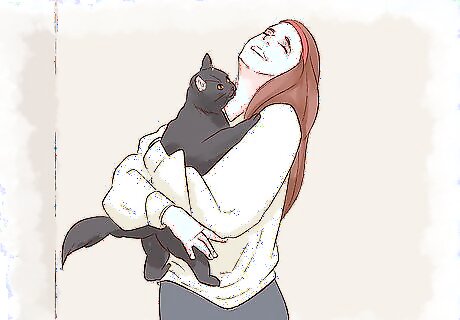
Play with your cat to reduce boredom and loneliness. If your cat is busy playing and interacting with you, it will be less likely to focus on obsessively licking itself. Try to spend at least a little time each day giving your cat attention, whether that means playing with toys or just having an extended cuddle session. Provide your cat with plenty of toys so that it can play and entertain itself even when you’re not around.
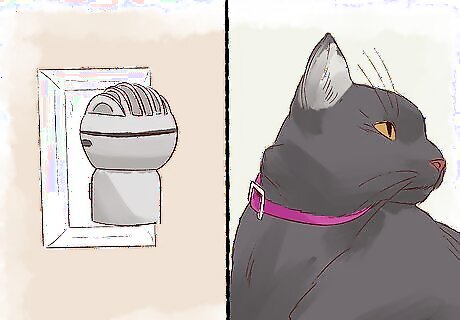
Try a calming aid, such as pheromone spray, for anxious cats. If your cat is high-strung and nervous, try spraying its favorite sleeping or resting areas with a pheromone spray or adding a diffuser to areas where it likes to hang out. You can also fit your cat with a calming collar. These aids may calm and relax your cat, making it less likely to self-soothe by licking its fur off. Look for feline pheromone sprays, diffusers, or collars online or at a pet supply store. Your vet’s office may also sell them.

Look into anxiety medications for severely stressed cats. If your cat is extra stressed—for example, due to a recent move or the introduction of a new pet or family member into the home—then medications can help it cope. Talk to your vet about trying a prescription anti-anxiety medication to calm your cat and reduce stress-related behavioral issues, such as obsessive grooming and licking. Your vet may recommend using medications in combination with other stress-relieving techniques, such as establishing a soothing daily routine for your cat or providing extra toys and hiding places.
Why is my cat licking its fur off?
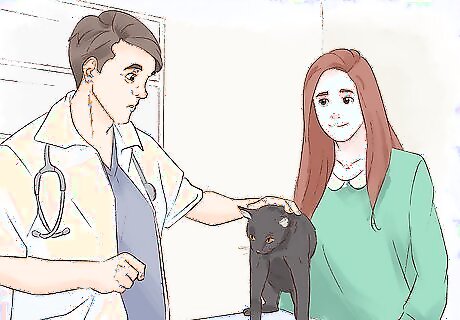
Cats might overgroom because of an underlying medical cause. Make an appointment with your vet to find out what might be causing your kitty to lick its fur off. They can also help you determine whether the problem is actually overgrooming or some other type of hair loss. Here are the most common medical reasons behind overgrooming: Infestations of parasites (like fleas, mites, or lice) Skin infection (look out for rashes, redness, scabs, or sores in the spots where your cat tends to lick its fur off) Food allergies or environmental allergies (pay attention to hair loss around the cat’s belly and back) Healing wounds (just like for humans, scabs can cause itchiness and discomfort) Neurological problems or thyroid imbalance (a vet can rule these out with lab work and testing)
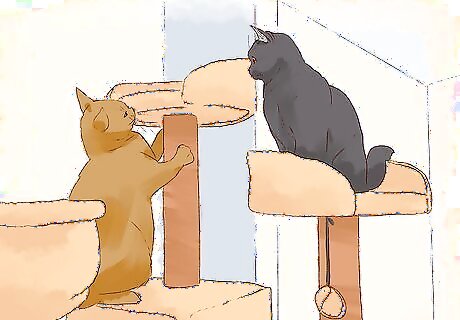
Over-grooming can also be a stress-related behavioral issue. Grooming is comforting for cats. For this reason, cats who are anxious or stressed sometimes lick themselves obsessively to the point of hair loss, especially on the inner thighs, front legs, and belly. Think about reasons your cat might be feeling anxious lately, such as a recent move, the introduction of a new pet or human family member, or changes in your regular routine. Look for ways to make your cat feel safer and more comfortable, such as: Keeping your cat separate from other pets that it doesn’t get along with, especially when you can’t supervise them together. You can also reduce stress in a multi-pet home by giving them access to separate litter boxes, feeding areas, and hiding places. Making your cat’s daily routine as predictable as possible. For instance, try to feed, groom, and play with your cat at the same times each day. Providing plenty of places where your cat can rest and hide, such as climbing towers and kitty condos.



















Comments
0 comment